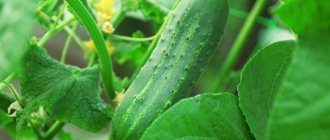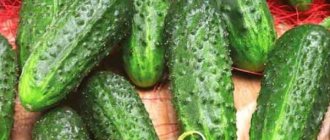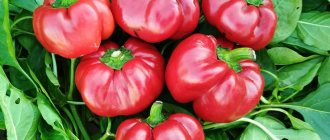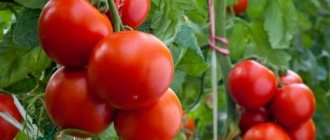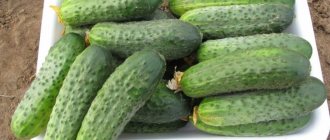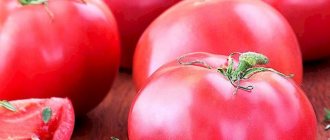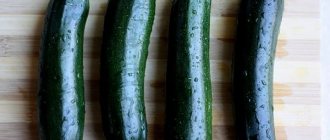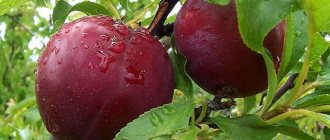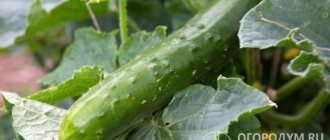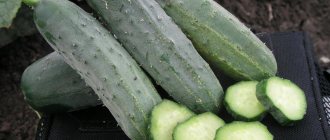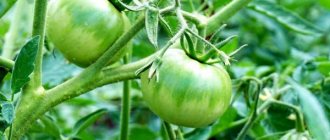Vegetable growing » Cucumbers
0
1787
Article rating
Kira Stoletova
Cucumber is a common vegetable crop. Almost no salad or preserve can do without this vegetable. The Vyatich F1 cucumber variety, known for its good fruit taste and high yields, has received special attention from gardeners.
Characteristics of cucumbers of the Vyatich variety
History of variety development
This cucumber variety was bred by Turkish breeders. But the cucumber hybrid Vyatich F1 was included in the Russian State Register only in 2021. At the same time, Russian seed companies do not produce seed material of this hybrid; all Vyatich F1 seeds come to Russian gardening stores directly from Turkey.
This hybrid is recommended for cultivation in greenhouse conditions in almost all Russian regions, and in the southern regions, the Vyatich cucumber grows well and bears fruit in garden beds.
Related article:
Cucumber Baby mini F1 - description and characteristics of an early variety
Description of the variety
The Vyatich F1 cucumber is distinguished by its early ripening period - from the moment of germination of the planting crop to the harvesting of the fruit, a little more than a month passes. Moreover, in greenhouse conditions, as well as in the southern regions in the garden, this vegetable crop can be grown twice per season - in the spring-summer and summer-autumn periods.
The cucumber vines of this variety are of medium length and grow no more than 1.9-2.1 m, the side shoots are quite short. A characteristic feature of this hybrid is that the fruits on the side shoots begin to set after the central stem has finished bearing fruit. The shoots are well leafy. The foliage is medium in size, with many veins, smooth, rich emerald color.
Since this cucumber hybrid belongs to the parthenocarpic type, only female flowers are formed on its vines, and the ovaries are formed without pollen. Therefore, the bushes of this hybrid do not require pollination. Cucumber flowers are small in size, intense yellow in color.
Flowers are usually formed in the axils of the leaves, each of which can form up to 2-4 ovaries.
Related article:
What do cucumbers like?
Ripening greens are of the gherkin type, their size is up to 12-14 cm. The shape of ripe gherkins is elongated and cylindrical. The skin is smooth, with small tubercles and medium spikes of white color. The pulp is compacted, tender, with a characteristic crunch; there is no bitterness in it at the genetic level. There are no voids in the pulp and do not appear even during heat treatment.
The taste of ripe cucumbers is pleasant, sweetish, delicate, with a characteristic cucumber aroma.
The harvested gherkins can be easily transported over any distance and can be stored under appropriate conditions for a long period.
What is a Vyatsky cucumber?
Next, a description of the variety will be considered. The culture was developed relatively recently - in 2021. In a short period of time, she managed to receive positive feedback from vegetable growers.
Vyatsky f1 belongs to the parthenocarpic hybrids of the female flowering type. The designation “parthenocarpic hybrid” indicates that the variety produces its fruits without pollination. The plant is convenient to grow in greenhouses, where there are practically no insects.
Parthenocarpic cucumbers have a number of advantages, including:
- fruits without bitterness;
- fast growth;
- long fruiting;
- the fact that they do not require pollination by insects;
- smooth fruit shape.
Vegetable growers love Vyatich for its super-earliness. The first harvest ripens within a month after the seedlings emerge. The ovaries are fasciculate. The culture is not fussy about the care and quality of the soil. The variety is immune to many common diseases. You can grow cucumbers in open and closed ground.
The hybrid easily tolerates short-term drought, rain, cool summers, and sudden temperature changes. There are no regional restrictions. Cucumber grows well in temperate climate zones. Seeds are sold in different countries.
Main characteristics of the variety
This cucumber hybrid is resistant to sudden changes in weather conditions, while their growth and ripening of greens does not stop either during a sharp cold snap, or in the heat, or during periods of drought. At the same time, the shape and size of the gherkins also do not change.
Related article:
Growing delicious cucumbers: secrets of experienced gardeners
Productivity
The productivity of the cucumber hybrid Vyatich F1 is high - at least 20 kg of ripe gherkins are collected from each square of area.
Area of application of fruits
Ripe greens have a pleasant taste, so they are used fresh, added to vegetable salads and various snacks. Also, cucumbers of this variety can be pickled and canned. The taste of gherkins does not deteriorate during heat treatment.
Characteristics of the species
The Vyatsky variety has a number of features:
- The fruits are suitable for salads, but the variety is not intended for canning.
- Ripening lasts 1 month, the species is classified as early ripening.
- The harvest from 1 bush reaches 12 kg.
The culture is suitable for both open and closed cultivation, but most often cucumbers are planted using seedlings. It is also recommended to use trellises when planting: this makes it easier to care for plants and increases the yield of bushes.
Cucumbers tolerate unfavorable conditions well; they are grown in almost any region of the temperate climate zone.
Description of the bush
The weaving of the variety is of the medium type, the ovaries have a bunch shape. Lateral shoots form quickly.
The type of flowering is female; in the leaf axils the number of female flowers varies from 1 to 3.
Description of fruits
Cucumbers of this variety have certain standards:
- cucumber length - 12 cm;
- diameter - 4 cm;
- average weight - 130 g.
There are no voids or bitterness in the pulp, the fruits are cylindrical in shape. The surface is medium-tubercular, with small white spines. Cucumbers have a delicate texture and a well-defined taste. The long shelf life and strength of the fruit allows them to withstand long-term transportation.
Diseases and pests
This cucumber hybrid has high resistance to most diseases characteristic of other cucumber varieties. However, many gardeners say that with unfavorable care and failure to follow the rules of agricultural technology, the Vyatich F1 cucumber can be affected by cladosporiosis, downy mildew and white rot.
If brown ulcers and a gray-olive velvety coating appear on the vegetative mass of cucumber vines and fruits, these are the first signs of cladosporiosis. To prevent this dangerous disease, cucumber bushes should be treated with a solution of Ordan, Kurzat R or Fundazol.
Read more about cucumber diseases in this article.
If cucumber vines are affected by downy mildew, then yellow spots appear on the leaf blades, which become oily after a few days. And on the back of the leaves a characteristic gray coating appears. Gradually the foliage curls up, dries and falls off. To combat the disease and for preventive purposes, you can use the following means:
- Previkur;
- Abiga Peak;
- Kurzatom;
- Order.
Related article:
The most important thing about the problems of cucumbers
White rot is a viral disease that can appear on the foliage, stems and fruits of this vegetable crop. The first symptoms of white rot are:
- the appearance of wet spots;
- white coating;
- the foliage curls, withers and gradually falls off.
To combat the disease, the chemical "Planriz" is usually used.
The main advantages of the variety
Hybrid Vyatich F1
The main advantages of the cucumber hybrid Vyatich F1 include:
- high productivity;
- early ripening of greens;
- Fruiting of bushes of this variety continues until autumn;
- high resistance to most diseases and changes in weather conditions;
- good taste and beautiful appearance of gherkins;
- ripe greens can be stored for a long time;
- unpretentiousness to growing conditions.
Features of planting and care
This cucumber hybrid can be planted using seedlings or non-seedling methods. But seed material is planted directly into open ground only in the southern regions, where the soil has already warmed up to 12-14 degrees Celsius by the time of planting in early to mid-May. The seed material of this hybrid is planted for seedlings in the second half of April.
The area for planting this vegetable crop is prepared in advance, preferably in the fall. After the harvest has been harvested from the garden, you can begin to cultivate the plot in the fall. First, all remnants of vegetation are removed along with the roots, then organic matter (humus or compost) is added. After this, you need to dig up the area using the bayonet of a shovel.
You also need to follow the rules of crop rotation and grow cucumbers after potatoes, cabbage, parsley, peas or beans.
Related article:
Great idea for growing cucumbers
When growing cucumber seedlings indoors, you need to maintain a temperature of 22-24 degrees Celsius. In order not to pick these seedlings with a delicate root system in the future, it is necessary to immediately place the seed material in separate containers. After germination, containers with plants are moved to well-lit windowsills.
From the moment the sprouts appear, the temperature in the room is reduced to +16-17 degrees, and the daylight hours for them should be at least 12-13 hours. Therefore, if there is a lack of natural light, phytolamps must be installed next to the growing seedlings.
Features of cultivation
This hybrid is suitable for any of 2 growing methods:
- using seedlings;
- planting seeds in open ground.
Vegetables grow well in sunny weather and are demanding when planting. Cucumber Vyatich f1 can be planted in any conditions, but it is better to do this in film greenhouses. To plant in open ground, the soil is fertilized and dug up in the fall. Although the seeds are pre-hardened, the soil must warm up to 12 °C.
The holes (about 3 cm deep) are watered with warm water, seeds are placed in them and dug in. The beds must be covered with oilcloth or other synthetic material.
Before planting a cucumber in a greenhouse, prepare the seedlings. When 4 leaves appear on the seedlings, you can start picking. The basic requirements for environmental conditions are the absence of frost and warm soil. This species prefers medium clay soil.
It is good if legumes, parsley, potatoes or cabbage previously grew at the planting site. The area of the bed for one seedling should be approximately 50x50 cm. One stem is left on it, and the first 4-5 internodes are blinded. As they grow, the shoots must be tied to a support.
Planting in open ground
The grown seedlings are planted in a permanent place after about a month, when at least 4-5 permanent leaves appear on it. This usually happens in the second ten days of May, when ground temperatures rise to 14-16 degrees Celsius.
Related article:
Secrets of July sowing of cucumbers
Seedlings of this hybrid should be planted on beds or seed material at a distance of 0.5 m from each other. In this case, the width of the rows should be at least 0.6 m. The direction of the beds should be strictly from north to south, in this case the cucumber vines will not block the sun from each other, and it will be easier to care for them and harvest.
Agricultural technology
The plant will have good immunity to diseases if it is properly cared for and the seeds are treated and the seedlings are hardened when sowing.
Hybrid Vyatsky is resistant to:
- powdery mildew;
- cucumber mosaic;
- downy mildew;
- olive spot;
- root rot.
To get high-quality seed material, you should purchase it at a gardening store. They can provide you with a product that is not expired, a certificate confirming its originality and the manufacturer’s brand. To check the suitability of seeds for planting, you need to immerse them in a salt solution. Those that can be planted will sink to the bottom, and empty ones will float to the surface.
Next, you need to follow a certain preparatory technology, which consists of a number of stages.
- Selection.
- Warming up.
- Soak.
If you want to plant cucumbers directly in the garden, you need to choose a period when the soil is warmed up as much as possible and a stable temperature has established at +12+13 oC. The soil for planting is prepared in the fall; it should be loose and well fertilized. The sunny side of the plot is suitable for cultivation, and the seeds need to be buried in the holes by 4 cm, and they should be 60 cm apart from each other.
It may be interesting What to do with barren flowers on cucumbers: treatment, prevention Varieties of cucumbers for the Moscow region: features of planting and care Characteristics and features of growing cucumber “Farmer f1”
When planting, the seeds are watered with warm water and covered with film to prevent frostbite of the sprouts. When using the seedling method of planting, seeds must first be:
- warm up;
- disinfect by placing in a weak manganese solution;
- dry by laying it on a horizontal, non-sticky surface;
- carry out treatment with special compounds that significantly accelerate growth and development.
With timely watering, provision of sufficient lighting and compliance with other requirements, the root system will develop actively and will be strong, strong and with stable immunity. A healthy bush is the key to a good harvest.
Transplanting seedlings into the ground
This process will not take too much time, but you need to be very careful not to damage the roots, which are fragile.
Unlike tomatoes, cucumber sprouts can become seriously ill and not everyone can recover them. Note!
Transplantation of seedlings into the ground is done at the moment when about 3-5 true leaves are formed, which confirms the maturity of the plant.
The soil is prepared warm, moist and 2 sprouts are enough per 1 m2. It is better to plant the Vyatsky hybrid where they previously grew:
- potato;
- cabbage.
This soil will be the most fertile.
Care
This variety is declared as unpretentious to care, but there are still minimum requirements, since to get a good result you need to ensure:
- watering;
- weeding;
- fertilizing
For irrigation, settled warm water is used, and the amount and volume of liquid depends on the frequency of precipitation and on growth activity. High humidity is required during the period when fruits form and ripen, which will have a beneficial effect on taste. Watering is done in two ways.
- Under the root. This option is ideal for adult bushes, since drops falling on the foliage will cause severe burns.
- Irrigation. This method is used at the stage of planting seeds and the appearance of the first sprouts.
The hybrid will begin to develop slowly and bear little fruit if the top layer of soil above the roots is hardened. To avoid the problem, loosening is done after each watering. The work is carried out as carefully as possible so as not to damage the roots
It is important to regularly remove weeds and yellowed leaves, which can suppress young shoots and cause increased consumption of moisture and nutrients for the plant. Both industrial formulations and mixtures prepared at home are suitable as fertilizers.
A natural solution based on onion peels and water in a ratio of 200 g:5 l is popular.
To create an effective mineral complex use:
- serum;
- water;
- iodine.
To 10 liters of water you need to add 1 liter of whey and about 16 drops of iodine.
Attention!
Among industrial products, preference is given to ready-made sulfate and nitrogen fertilizers.
You can use yeast-based fertilizer, which will require 1 pack per 10 liters of water. The introduction of the nutrient solution is done during watering.
Further care
Although this cucumber hybrid is unpretentious to growing conditions, the Vyatich F1 cucumber bushes still need to be provided with timely watering, regularly apply fertilizer and loosen the root zone of the plants. You should also tie cucumber vines to trellises.
Watering the bushes of this cucumber is done 2-3 times a week with warm, settled water. During periods of drought, plants should be watered every other day. Water is applied strictly at the root so that drops of moisture do not fall on the foliage and shoots of cucumbers.
Related article:
Growing cucumbers: in a barrel, hut and on a trellis
Loosening of the root zone of the bushes of this cucumber is carried out after watering or rain, breaking up the dry crust that forms on the soil.
The lashes are tied to trellises or a special cucumber net to make them easier to care for and harvest.
After the sprouts appear or a couple of weeks after transplanting the seedlings into the beds, you need to apply fertilizer for the first time. Typically, fertilizers containing nitrogen are used for this. From the moment the buds appear, rotted manure, greenfinch or mineral fertilizers containing phosphorus and potassium are applied under the cucumber vines.
Reviews from summer residents
Farmer-bloggers Oleg and Irina Stepura (Krasnodar region) left a review about this hybrid. They grew the Vyatich F1 cucumber in open ground conditions on a personal plot. The fruits were not afraid of the sun, but required disease prevention. The culture confirmed all the declared qualities. Olga (Voronezh region) praised the cucumber for its taste, productivity and resistance to negative factors. The fruits do not outgrow, but their skin is prickly.
The Vyatich F1 cucumber is not an expensive variety, although it is of foreign origin. He has many positive traits. Compared to the advantages, the disadvantages are minor. But finding varietal seeds on sale is not easy.
